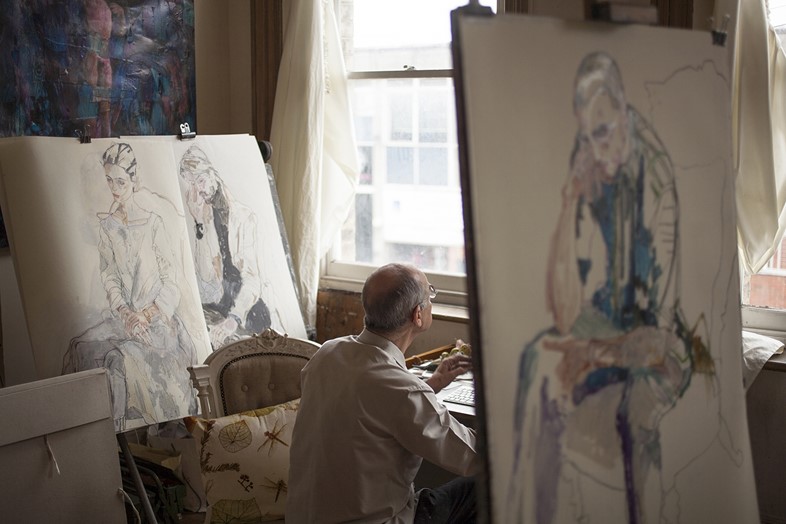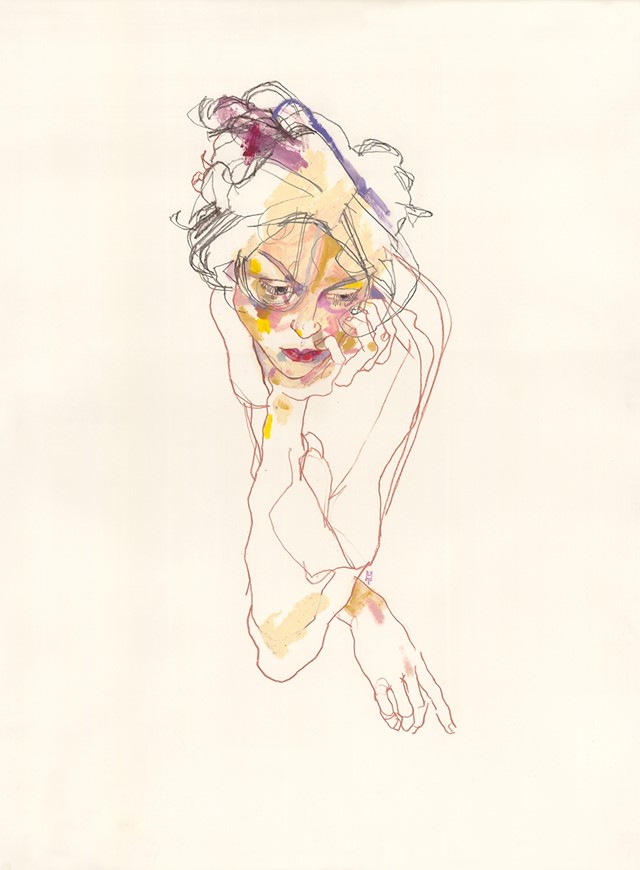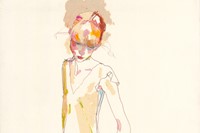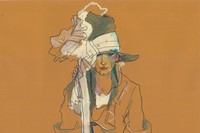We talk to Howard Tangye about drawing, fashion and his new Kickstarter campaign
Howard Tangye has been an influential force in fashion for decades. As Head of Womenswear Design at Central Saint Martins, he has tutored the likes of John Galliano, Stella McCartney, Christopher Kane, Julie Verhoeven, Richard Nicoll, and Hussein Chalayan, to name but a few. At the same time, Tangye has kept up his own art practice, and a new monograph, Within, offers privileged access to his creative process and output. The book, which features reproductions of drawings of the many sitters who have visited Tangye at his private studio over the years, is the first such collection of its kind, with never-before-seen portraits accompanied by written contributions from Abraham Thomas, Curator of Design at the V&A, and Marie McLoughlin, dress historian at the University of Brighton. Unwilling to compromise on quality or content, Tangye and design studio STSQ have worked together to fund Within via a Kickstarter campaign. Here, Tangye describes his singular approach to drawing, the strong relationships he builds with his sitters, and how pledging has worked for the project.
You don’t describe yourself as a fashion illustrator. Why not?
When I draw someone, I’m not really concerned about the clothing; I look for the body through the clothes. But because I’ve lent my work to fashion publications, and some drawings appeared in the Galliano book, people associate me with this type of drawing.
When I started out as a fashion student at Saint Martins School of Art, I wanted to be a designer, absolutely, drawing was only a subsidiary project. Then I discovered I loved it, and after Saint Martins I took up a scholarship at Parsons in New York, which was purely drawing. At the time, there was a huge demand from the New York daily newspapers for illustrations, and particularly fashion illustrations, so I thought I’d take my portfolio around. I immediately got the feedback that these were not really fashion illustrations, these were life drawings – people would even buy them straight from my portfolio.

You’ve said that for you, drawing is about the relationship with the sitter. How is this dynamic important?
Thirty years ago, I invited someone to come sit for me, and I was aware of an energy between us, it was something special, it wasn’t just superficial, and it affected the drawing. I thought, this is the key thing I need to have, it’s not just an illustration; each one is about the individual sitter.
Now, I try to maintain that; I choose somebody hoping we’ll have that connection; otherwise it doesn’t work. I believe the sitter’s role is really important, they’re working as well, they’re not just sitting there like a vase of flowers or something.
"I believe the sitter’s role is really important, they’re working as well, they’re not just sitting there like a vase of flowers or something"
What do you look for in a sitter? Is it something you can put into words?
Sometimes someone just catches your eye for any kind of reason. It could be the way they stand or the way they hang their head, various aspects of their character that come through their physicality. How they move is really important, because you can have somebody who is gorgeous but they’re like wood. When someone comes to sit for me, they have to be completely themselves.
In the Kickstarter film you say you’re interested in the physical aspect of drawing...
Yes. The medium is quite important for expressing my feelings about the person I’m drawing. It’s not just about tracing a line; the lines are really about weight and interpretation, about capturing what I’m trying to emphasise or pick up from their character. It’s also about the physicality of the person. I want it to be a real body, a real person, not just a flat, stylised thing.
There is a lightness of touch to your work that makes it seem deceptively simple. Which mediums do you work in?
I use big oil paint sticks, the ones by R&F – which is an American company. I can use them directly on paper, or mix them with brushes, scrape them on, or sometimes I just use my fingers, they’re very versatile. I use graphite, always, oil pastels, sometimes I use chalk. So it’s really mixed media, and quite physical.
I particularly love working with Derwent pencils, and it’s not always black, it’s often indigo or other blues or purples, which are not really natural colours, but they’re the ones I respond to strongly.
How is the Kickstarter campaign going?
I’m enjoying it like a fairground ride. It’s exciting. Stina and Louise, who run STSQ, have organised it so well, and there’s been no compromise about the book. The paper they’ve selected is beautiful, as are the reproductions. I’ve never seen such a perfect colour match. I’ve held them up next to the original drawing and you cannot tell the difference – the book feels more like a folio of real drawings.
Are your original works available commercially?
In the past I’ve only really sold works through word of mouth or through and for a charity called CHASE, because I’ve never really sought it out, but now I’m with Hus Gallery, a new, young gallery, which is really exciting. It’s difficult to find people you can trust, because for me, these drawings are not just drawings, they’re really special.
You can contribute to the Within Kickstarter campaign until Friday, 5 July, and receive rewards for various pledge levels. Within will be available this autumn.
Text by Ananda Pellerin
Ananda Pellerin is a London-based writer and regular contributor to anothermag.com.



